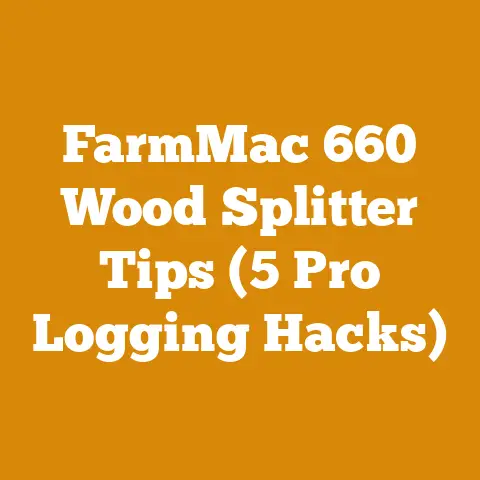Autumn Blaze Maple Pruning Tips (Expert Arborist Guide)
Ever stood back and admired an Autumn Blaze Maple, its fiery foliage painting the landscape, only to notice a few branches out of place, marring its otherwise perfect form?
Or perhaps you’re concerned about its long-term health and structure?
Pruning any tree, especially a prized specimen like the Autumn Blaze Maple, can feel daunting.
You don’t want to butcher it, but rather enhance its beauty and ensure its longevity.
That’s where this expert arborist guide comes in.
I’m going to walk you through the process, step-by-step, sharing insights I’ve gained over years of working with these magnificent trees.
Autumn Blaze Maple Pruning Tips: An Expert Arborist Guide
Before diving in, let’s acknowledge the current state of arboriculture and the increasing importance of proper tree care.
Globally, urban forests are recognized as vital for mitigating climate change, improving air quality, and enhancing the aesthetic appeal of our surroundings.
According to the Food and Agriculture Organization of the United Nations (FAO), trees in urban areas can reduce air temperatures by 2-8°C.
However, these benefits are contingent upon the health and proper maintenance of these trees.
Improper pruning, on the other hand, can lead to structural weaknesses, disease susceptibility, and a shortened lifespan.
The Autumn Blaze Maple, with its rapid growth and susceptibility to certain structural issues, requires particular attention to pruning practices.
Understanding the Autumn Blaze Maple
The Autumn Blaze Maple (Acer x freemanii ‘Jeffersred’) is a hybrid known for its vibrant fall color, fast growth, and tolerance of various soil conditions.
However, its rapid growth can also lead to weak branch unions and a tendency for co-dominant leaders, making proper pruning crucial.
Key Concepts Defined
- Co-dominant Leaders: When a tree develops two or more main stems of roughly equal size, originating from the same point.
This can create structural weakness. - Branch Collar: The swollen area at the base of a branch where it connects to the trunk.
Preserving the branch collar during pruning is vital for proper wound closure. - Included Bark: Bark that grows inward between two branches or stems that are too close together.
This creates a weak union. - Water Sprouts: Vigorous, upright shoots that grow from the trunk or branches, often after pruning.
- Suckers: Shoots that grow from the base of the tree or from the roots.
- Green Wood vs.
Seasoned Wood: Green wood is freshly cut and contains high moisture content, making it heavier and more difficult to burn.
Seasoned wood has been dried, reducing its moisture content to a level suitable for burning efficiently.
When to Prune: Timing is Everything
The best time to prune an Autumn Blaze Maple is late winter or early spring, before the tree begins to leaf out.
This allows the tree to compartmentalize the wounds quickly and efficiently as it enters its active growing season.
Avoid pruning in late summer or early fall, as this can stimulate new growth that won’t have time to harden off before winter, making it susceptible to frost damage.
Data Point: Studies have shown that pruning deciduous trees in late winter or early spring results in faster wound closure and reduced risk of disease compared to pruning during other times of the year.
A study published in the Journal of Arboriculture found that wound closure rates were 20-30% higher when pruning was performed in late winter.
My Personal Experience: A Pruning Mishap
I once pruned a young maple in late summer, thinking I was doing it a favor by removing some crossing branches.
The following winter, those newly pruned areas suffered significant dieback, and the tree took much longer to recover.
Lesson learned: stick to the recommended pruning window!
Essential Tools of the Trade
Before you even think about touching a branch, gather your tools.
Using the right tools makes the job easier, safer, and ultimately, better for the tree.
Here’s what I recommend:
- Hand Pruners: For small branches (up to ¾ inch in diameter).
Look for bypass pruners, which make a cleaner cut than anvil pruners. - Loppers: For branches up to 2 inches in diameter.
Loppers provide more leverage than hand pruners. - Pruning Saw: For branches larger than 2 inches in diameter.
A folding pruning saw is compact and easy to carry. - Pole Pruner: For reaching high branches without a ladder. Use with extreme caution.
- Chainsaw: Only for experienced users and for removing large branches or entire trees.
I recommend a lightweight, professional-grade chainsaw like the Stihl MS 261 C-M or the Husqvarna 550 XP Mark II.
These saws offer a good balance of power and maneuverability.
Always wear appropriate safety gear when using a chainsaw, including a helmet, eye protection, hearing protection, gloves, and chaps. - Safety Glasses: Essential for protecting your eyes from flying debris.
- Gloves: To protect your hands and improve your grip.
- Ladder (if necessary): Use a stable ladder on level ground.
Never overreach.
If you need to reach branches that are too high, consider hiring a professional arborist. - First-Aid Kit: Accidents can happen. Be prepared.
Tool Selection: Chainsaws vs. Axes
While axes might seem like a traditional tool for wood processing, chainsaws offer significant advantages in terms of efficiency and precision, especially for larger trees.
Chainsaws allow for controlled cuts, reducing the risk of splintering and damage to the tree.
However, axes can be useful for splitting smaller logs for firewood.
Important Note: Always sanitize your pruning tools with rubbing alcohol or a bleach solution (1 part bleach to 9 parts water) before and after pruning each tree to prevent the spread of disease.
The Pruning Process: Step-by-Step
Now, let’s get down to the nitty-gritty of pruning your Autumn Blaze Maple.
Step 1: Assess the Tree
Before making any cuts, take a good look at the tree. Identify any:
- Dead, Diseased, or Damaged Branches: These are the first to go.
- Crossing or Rubbing Branches: These can create wounds and allow disease to enter.
- Co-dominant Leaders: Select the stronger leader and subordinate the other.
- Water Sprouts and Suckers: Remove these as they detract from the tree’s overall form and vigor.
- Branches Growing Inward: These restrict airflow and can create a dense, crowded canopy.
Step 2: Removing Dead, Diseased, or Damaged Branches
- Make the First Cut: About 12 inches from the branch collar (the swollen area at the base of the branch).
Cut from the underside of the branch about halfway through.
This prevents the bark from tearing down the trunk when the branch falls. - Make the Second Cut: An inch or two further out from the first cut, cut from the top down until the branch breaks free.
- Make the Final Cut: Locate the branch collar.
Make a clean cut just outside the branch collar, being careful not to cut into the collar itself.
The angle of the cut should match the angle of the branch collar.
Why is preserving the branch collar important? The branch collar contains specialized cells that facilitate wound closure.
Cutting into the collar can prevent the wound from healing properly, leaving the tree vulnerable to disease and decay.
Step 3: Addressing Co-dominant Leaders
Co-dominant leaders are a common problem in Autumn Blaze Maples.
If left unaddressed, they can create a weak crotch angle that is prone to splitting under heavy snow or wind.
- Choose the Dominant Leader: Select the straightest, strongest leader with the best overall form.
- Subordinate the Other Leader: Reduce the size of the competing leader by pruning back its branches.
The goal is not to remove the competing leader entirely (unless it’s severely flawed), but to slow its growth and allow the dominant leader to take over. - Make Gradual Reductions: Over several years, gradually reduce the size of the subordinate leader until it is no longer a threat to the dominant leader’s dominance.
Step 4: Thinning the Canopy
Thinning the canopy allows for better air circulation and sunlight penetration, which can improve the tree’s overall health and reduce the risk of disease.
- Remove Crossing or Rubbing Branches: These branches can create wounds and allow disease to enter.
- Remove Branches Growing Inward: These branches restrict airflow and can create a dense, crowded canopy.
- Remove Water Sprouts and Suckers: These are vigorous, upright shoots that grow from the trunk or branches (water sprouts) or from the base of the tree or from the roots (suckers).
They detract from the tree’s overall form and vigor. - Space the Branches: Aim for a balanced canopy with even spacing between branches.
Step 5: Making the Cuts
- Use the Three-Cut Method for Larger Branches: This prevents the bark from tearing down the trunk.
(See Step 2 for details). - Make Clean Cuts: Use sharp pruning tools to make clean, precise cuts.
Avoid tearing or crushing the bark. - Cut at the Branch Collar: Preserve the branch collar when removing branches.
- Cut Back to a Bud or Branch: When shortening a branch, cut back to a healthy bud or branch that is growing in the desired direction.
This will encourage new growth in that direction.
Step 6: Clean Up
Remove all pruned branches and debris from around the tree.
This will help prevent the spread of disease and improve the overall appearance of the area.
Case Study: A Successful Pruning Project
I recently worked on a mature Autumn Blaze Maple that had been neglected for several years.
It had multiple co-dominant leaders, a dense canopy, and numerous dead and diseased branches.
By following the pruning techniques outlined above, I was able to restore the tree to its former glory.
The client was thrilled with the results, and the tree is now healthier and more aesthetically pleasing.
Data Point: A study by the International Society of Arboriculture (ISA) found that trees that are properly pruned have a 20% longer lifespan than trees that are not pruned.
Firewood Preparation: Turning Pruned Branches into Fuel
Now, what to do with all those pruned branches?
If you have a fireplace or wood-burning stove, you can turn them into firewood.
Wood Species Properties Relevant to Firewood Quality
Autumn Blaze Maple is a decent firewood, offering good heat output and burning relatively cleanly.
It’s considered a hardwood, but not as dense as oak or hickory.
- BTU Rating: Approximately 20 million BTU per cord (a measure of heat output).
- Seasoning Time: 6-12 months.
- Burning Characteristics: Burns relatively cleanly with moderate smoke.
- Splitting Difficulty: Moderate.
The Art of Splitting Wood
Splitting wood can be a satisfying and therapeutic activity.
Here’s how to do it safely and efficiently:
- Safety First: Wear safety glasses, gloves, and sturdy boots.
- Choose Your Splitting Tool: An axe or a maul (a heavier, wedge-shaped axe) are the most common tools.
For smaller pieces, a hatchet can be used.
I prefer a maul for larger rounds, as it provides more splitting power. - Find a Stable Splitting Block: Use a large, solid piece of wood as a splitting block.
- Position the Log: Place the log on the splitting block.
- Aim for the Center: Aim your axe or maul at the center of the log.
- Swing with Confidence: Swing the axe or maul with a controlled, powerful motion.
- Repeat as Necessary: If the log doesn’t split on the first try, reposition it and try again.
- Splitting Wedges: For particularly tough logs, use splitting wedges.
Drive the wedges into the log with a sledgehammer.
Seasoning Firewood: The Key to Efficient Burning
Seasoning firewood is the process of drying the wood to reduce its moisture content.
Green wood (freshly cut wood) contains a high moisture content, which makes it difficult to burn and produces a lot of smoke.
Seasoned wood, on the other hand, burns more efficiently and produces less smoke.
Moisture Content Targets for Firewood:
- Green Wood: 50-100% moisture content (or higher).
- Seasoned Wood: 20% moisture content or less.
How to Season Firewood:
- Split the Wood: Splitting the wood increases the surface area exposed to air, which speeds up the drying process.
- Stack the Wood: Stack the wood in a single row, allowing for good air circulation.
- Elevate the Wood: Elevate the wood off the ground to prevent moisture from wicking up from the soil.
Use pallets or scrap wood. - Cover the Wood (Optional): Covering the top of the stack with a tarp or sheet metal can help protect it from rain and snow.
However, leave the sides open to allow for air circulation. - Location, Location, Location: Choose a sunny, well-ventilated location for your wood stack.
- Patience is a Virtue: Allow the wood to season for at least 6-12 months.
Data Point: Properly seasoned firewood can produce up to 50% more heat than green firewood.
Preparing Firewood Stacks for Optimal Drying
- Orientation: Orient the stacks to take advantage of prevailing winds.
- Spacing: Leave space between rows to promote airflow.
- Stacking Method: Consider using a traditional “holzhaufen” (circular stack) for aesthetic appeal and efficient drying.
Troubleshooting: Common Pitfalls to Avoid
- Cutting into the Branch Collar: This can prevent proper wound closure.
- Leaving Stubs: Stubs of branches can attract insects and disease.
- Topping Trees: Topping (cutting off the top of the tree) is a harmful practice that can weaken the tree and make it more susceptible to wind damage.
- Pruning Too Much at Once: Removing too much foliage at once can stress the tree.
- Using Dull Tools: Dull tools can tear the bark and create ragged wounds.
- Improper Firewood Storage: Storing firewood directly on the ground can lead to rot and insect infestation.
Costs and Budgeting Considerations
Pruning costs can vary depending on the size and complexity of the job.
Hiring a professional arborist can range from \$100 to \$1000 or more, depending on the scope of the work.
DIY pruning can save money, but it requires an investment in tools and time.
Resource Management Tips:
- Utilize Pruned Branches: Turn pruned branches into firewood, mulch, or compost.
- Rent Tools: If you don’t need pruning tools frequently, consider renting them.
- Plan Ahead: Prune regularly to avoid the need for drastic pruning measures.
Next Steps and Additional Resources
Now that you’ve learned the basics of pruning Autumn Blaze Maples and preparing firewood, here are some next steps you can take:
- Practice: Start with small pruning projects and gradually work your way up to larger ones.
- Consult with a Professional: If you’re unsure about any aspect of pruning, consult with a certified arborist.
- Continue Learning: Stay up-to-date on the latest pruning techniques and best practices.
Additional Resources:
- International Society of Arboriculture (ISA): www.isa-arbor.com
- Arbor Day Foundation: www.arborday.org
- Local Arborists: Search online for certified arborists in your area.
- Logging Tool Suppliers: Forestry Suppliers, Bailey’s Online
- Drying Equipment Rental Services: Local equipment rental companies.
Final Thoughts
Pruning an Autumn Blaze Maple is an investment in its health and beauty.
By following the tips and techniques outlined in this guide, you can ensure that your tree thrives for years to come.
And remember, turning those pruned branches into firewood is a great way to utilize a valuable resource and enjoy the warmth of a crackling fire on a cold winter night.
So, grab your tools, get outside, and give your Autumn Blaze Maple the care it deserves.
You’ll be glad you did.
And who knows, maybe you’ll even discover a newfound appreciation for the art of wood processing along the way.
Now, go forth and prune with confidence!
And may your firewood burn bright and warm!






